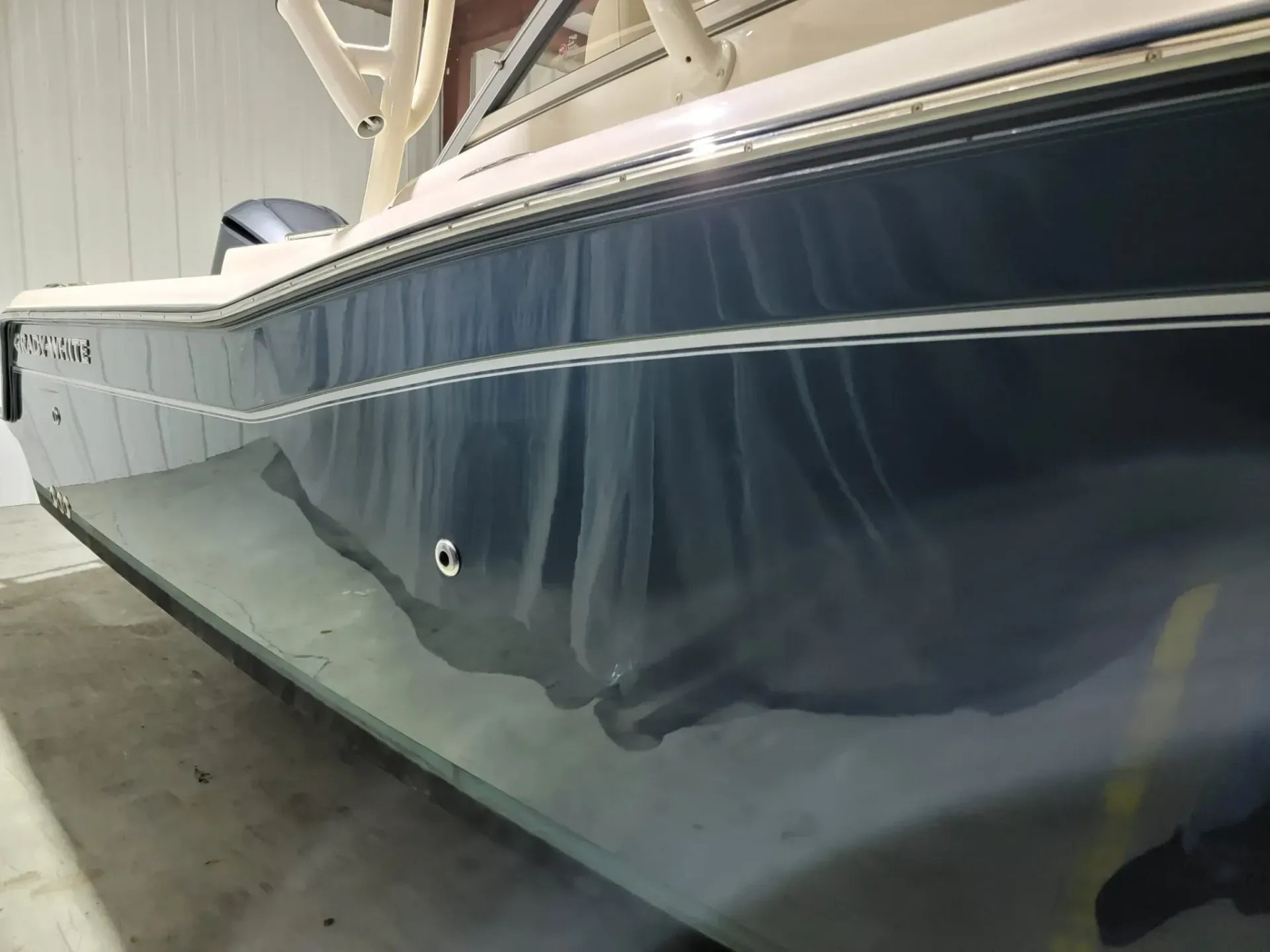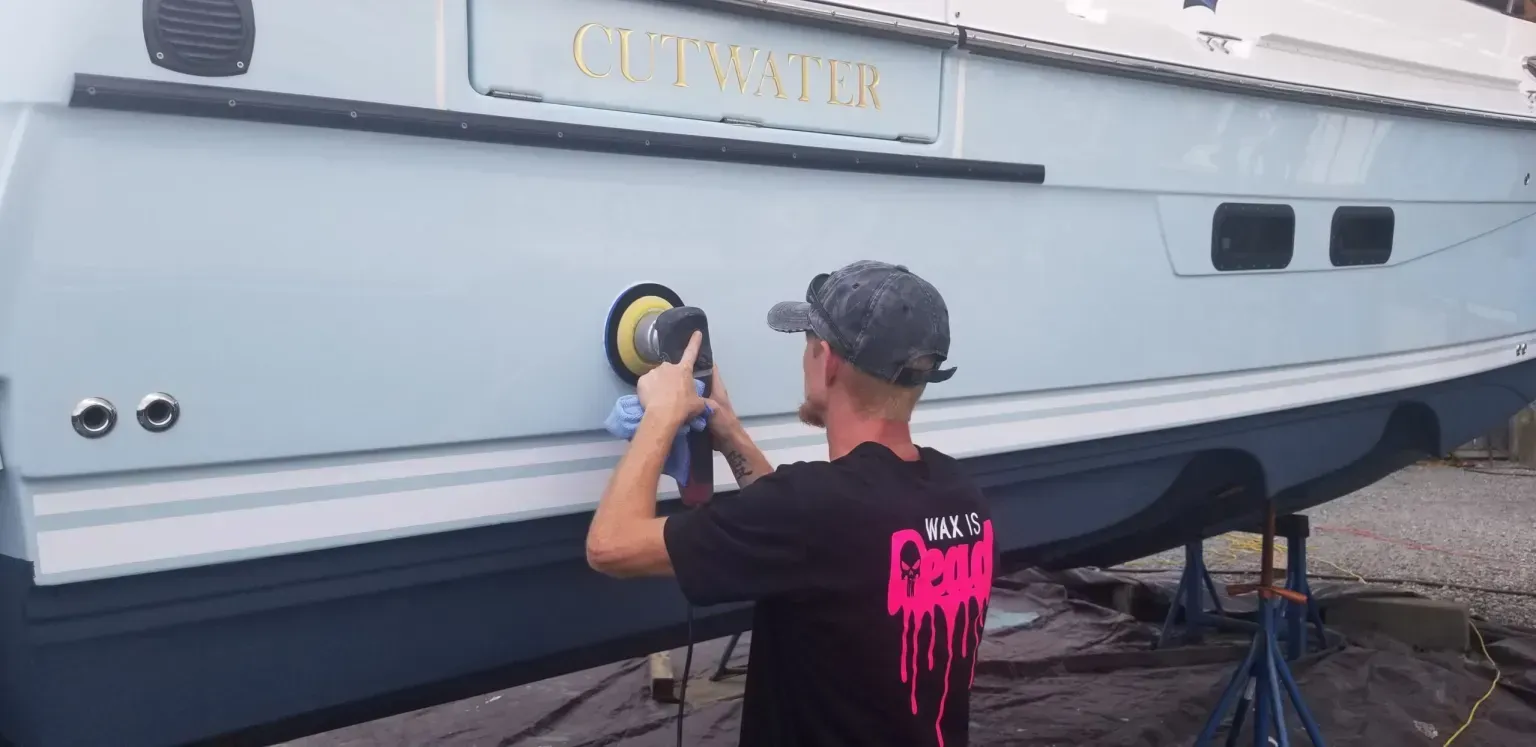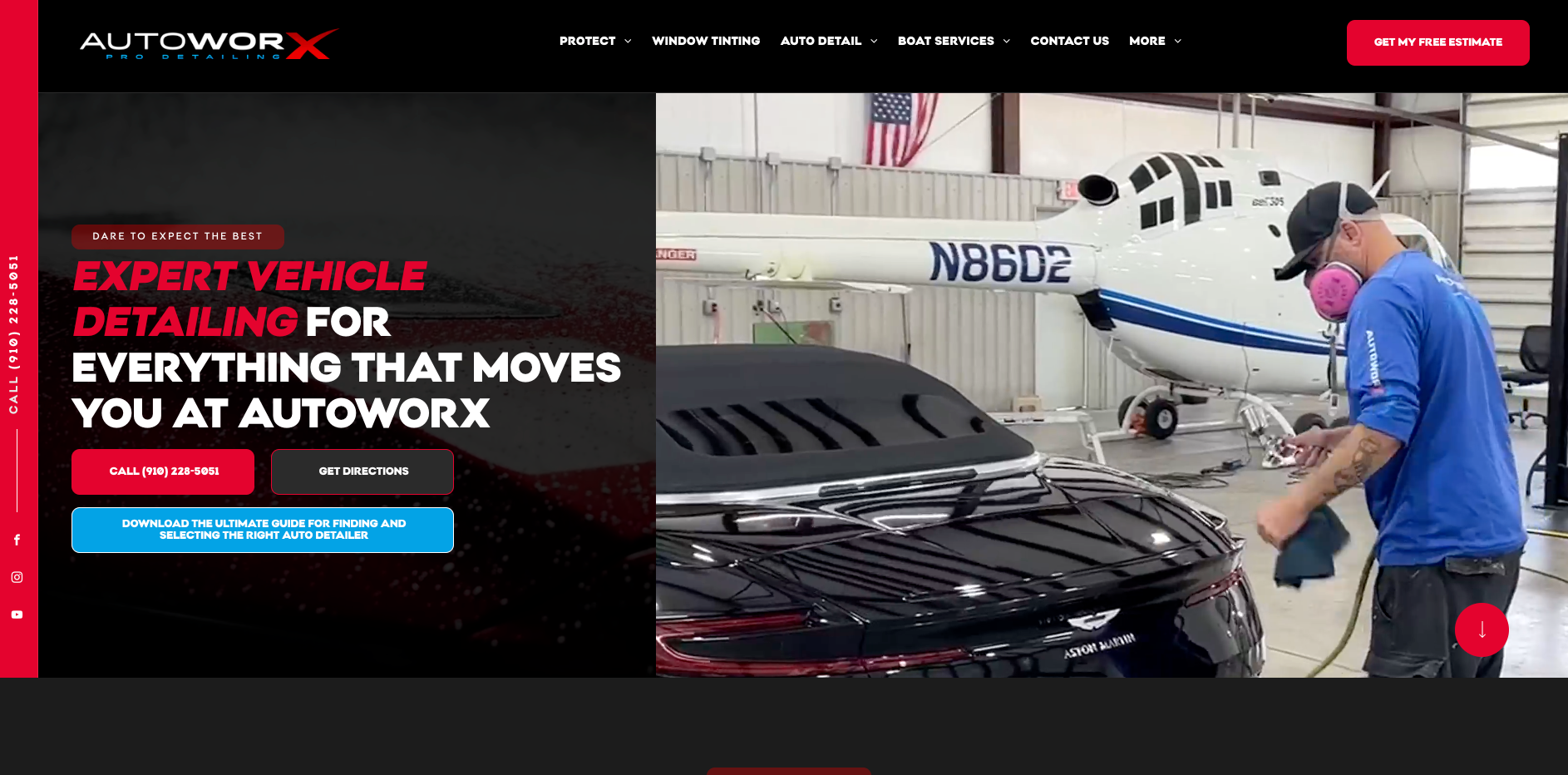Benefits of Ceramic Coating For Vehicle Paint Protection In Coastal Areas
CALL (910) 228-5051
Living in coastal areas can be a dream come true with the picturesque views, soothing sounds of the waves, and the fresh ocean breeze. However, this idyllic setting also comes with its challenges, particularly for vehicle owners. Coastal areas are notorious for their harsh environments that can wreak havoc on the paintwork of cars. From saltwater spray to high levels of humidity, the elements can lead to corrosion, fading, and peeling of paint, ultimately reducing the aesthetic appeal and value of your vehicle.
To combat these effects and ensure the longevity of your vehicle’s paintwork, one of the most effective solutions is ceramic coating. Ceramic coating is a liquid polymer that chemically bonds with the vehicle’s factory paint, creating a protective layer that enhances durability and resistance against various environmental factors. Unlike traditional waxes or sealants, ceramic coating provides long-lasting protection and requires minimal maintenance. AutoworX Pro Detailing is the exclusive and licensed installer for premium brand – Bespoke Ceramic Coating.
The primary benefit of ceramic coating in coastal areas is its ability to shield your vehicle’s paint from saltwater damage. Saltwater contains corrosive properties that accelerate the oxidation process, leading to rust, pitting, and overall deterioration of the paint. With a ceramic coating, the protective layer acts as a barrier against the saltwater, preventing it from coming into direct contact with the car’s paintwork. This significantly reduces the risk of corrosion and keeps your vehicle looking pristine for longer.
Additionally, ceramic coating is formulated to withstand the high levels of moisture and humidity found in coastal regions. Moisture can seep into the microscopic imperfections on the surface of the paint, leading to the growth of mold, mildew, and even rust. The hydrophobic properties of ceramic coating repel water, preventing it from penetrating the paint and causing damage. This not only enhances the appearance of the vehicle but also makes it easier to clean, as dirt and grime slide off effortlessly.
Furthermore, the UV resistance provided by ceramic coating is crucial in coastal areas where the sun’s rays can be particularly harsh. UV rays can cause paint to fade, lose its shine, and become vulnerable to cracking. Ceramic coating acts as a sunscreen for your vehicle, blocking out harmful UV rays and minimizing the effects of prolonged sun exposure. This ensures that your vehicle’s paint retains its vibrant color and original factory finish, even when exposed to the coastal sunshine.
In conclusion, investing in ceramic coating for your vehicle in a coastal area is a wise decision. Its protective properties shield your car’s paint from saltwater damage, moisture-related issues, and UV radiation. By applying a ceramic coating, you can keep your vehicle looking new, maintain its value, and enjoy an added layer of protection against the harsh coastal elements.
Harsh conditions faced by vehicles in coastal areas such as saltwater, UV rays, and sand

Coastal areas are known for their picturesque views and idyllic beach settings. However, these picturesque locations often pose significant challenges for vehicles due to the harsh conditions they face. From saltwater to intense UV rays and sand, vehicles in coastal areas are constantly exposed to elements that can deteriorate their paintwork over time.
One of the primary culprits that can wreak havoc on a vehicle’s exterior is saltwater. The high salt content in the air, particularly in coastal regions, can lead to corrosion and rust on metal surfaces. When saltwater contacts the surface of a vehicle, it can accelerate the oxidization process, causing paint to chip and fade much faster than in non-coastal locations. This not only affects the aesthetic appeal of the vehicle but also compromises its structural integrity.
UV rays, another significant challenge faced by vehicles in coastal areas, can cause extensive damage to the paintwork. The intense sunlight found in coastal regions can lead to the gradual fading of colors, making the vehicle appear dull and lackluster. Prolonged exposure to UV rays can also cause the paint to crack and blister, leaving the underlying metal exposed to further damage.
Sand, a characteristic feature of coastal areas, can also wreak havoc on a vehicle’s exterior. The fine particles of grit can become abrasive when they come into contact with a vehicle’s paintwork. Over time, this abrasion can leave behind scratches and swirl marks, diminishing the overall appearance of the vehicle.
To combat these challenges and protect a vehicle’s paintwork in coastal areas, ceramic coating has proven to be highly effective. Unlike traditional wax or sealants, ceramic coatings form a strong and durable layer of protection on the vehicle’s surface, acting as a barrier against saltwater, harmful UV rays, and sand. The ceramic coating’s hydrophobic properties repel water effectively, preventing saltwater from corroding the paint and minimizing the risk of rust formation.
Moreover, ceramic coatings provide excellent resistance against UV rays, minimizing the harmful effects of sunlight on the vehicle’s paintwork. With its heat-resistant properties, a ceramic coating acts as a shield, reducing the risk of paint fading, cracking, or blistering in coastal areas.
Furthermore, ceramic coatings create a self-cleaning effect, making it easier to remove sand particles that accumulate on the vehicle’s surface. The smooth and hydrophobic nature of the coating prevents sand from sticking to the paint, ensuring that any residue can be easily washed away without causing damage.
Traditional methods of vehicle paint protection and their limitations in coastal environments

Coastal areas present unique challenges when it comes to protecting your vehicle’s paint. The combination of saltwater, humidity, and environmental contaminants can be harsh on the exterior surfaces of your vehicle. This section will provide an overview of traditional methods of vehicle paint protection and discuss their limitations in coastal environments.
One conventional method often used for vehicle paint protection is waxing. Wax creates a temporary barrier between the paint and the elements, which helps to reduce the effects of UV rays, dirt, and minor scratches. However, in coastal areas, where saltwater is abundant, wax alone may not be sufficient. The salt can easily penetrate the wax, causing corrosion and damage to the paint finish.
Another popular option for paint protection is paint sealant. This synthetic product is designed to provide a longer-lasting barrier against environmental elements. Paint sealants create a stronger protective layer compared to wax and offer better resistance to UV damage, fading, and minor scratches. However, like wax, paint sealants may not effectively shield your vehicle against the corrosive effects of saltwater in coastal environments.
Clear bra or paint protection film (PPF) is another traditional method used to protect vehicle paint. PPF is a transparent film that is applied to vulnerable areas, such as the hood, fenders, and door edges, to shield the paint from scratches, stone chips, and minor impacts. While PPF can provide a reliable layer of protection, saltwater exposure can still cause damage to unprotected areas of the vehicle’s paint.
The limitations of these traditional methods in coastal environments highlight the need for more advanced paint protection solutions. One such solution is ceramic coating. Ceramic coating is a liquid polymer that chemically bonds with the paint surface, creating a durable protective layer. This coating is designed to be hydrophobic and repellent to water, salt, dirt, and other contaminants, making it an ideal choice for coastal areas.
Unlike traditional methods, ceramic coating provides long-term protection against UV damage, oxidation, fading, and corrosion caused by saltwater exposure. It forms a strong bond with the paint surface, ensuring that it remains intact even in harsh coastal conditions. Additionally, ceramic coating enhances the gloss and shine of your vehicle’s paint, giving it a polished and professional look.
Benefits of ceramic coating in providing long-term protection against saltwater corrosion
Ceramic coating has gained popularity as one of the most effective forms of vehicle paint protection, particularly for those living in coastal areas. The constant exposure to saltwater and its corrosive effects can greatly impact the appearance and longevity of a car’s exterior. That’s where ceramic coating comes in, offering long-term protection against saltwater corrosion.
One of the key benefits of ceramic coating is its ability to create a hydrophobic surface on the vehicle. This means that water, including saltwater, is repelled from the surface rather than being absorbed. By forming a protective layer on the paint, ceramic coating reduces the chances of saltwater reaching the metal and causing corrosion. This is especially important in coastal areas where the mist and humidity can accelerate the saltwater corrosion process.
Additionally, ceramic coatings offer remarkable durability. The protective layer formed by the coating is resistant to fading, oxidation, and chemical damage caused by saltwater exposure. Unlike traditional wax or sealants, ceramic coatings are designed to last for years, providing a long-term solution for vehicle paint protection.
Furthermore, ceramic coatings require minimal maintenance compared to other protective options. The hydrophobic properties of the coating make it easier to clean the vehicle as dirt, grime, and salt residues have a hard time adhering to the treated surface. This not only saves time and effort but also eliminates the need for frequent washing, which can potentially cause abrasion to the paint over time.
In coastal areas, where the combination of saltwater and sunlight can double the damaging effects on a vehicle’s paint, ceramic coating emerges as a reliable defense mechanism. With its ability to resist saltwater corrosion, create a hydrophobic surface, and provide long-lasting protection, ceramic coating ensures that your vehicle’s paint maintains its pristine appearance, ultimately enhancing its value and longevity.
Investing in a ceramic coating for your vehicle is a wise decision, especially if you live in a coastal region. By protecting your car from the harmful effects of saltwater, you can enjoy peace of mind knowing that your vehicle’s paint will continue to look professional and well-maintained for years to come.
The Durability of ceramic coating can withstanding UV rays and prevent paint fading

Ceramic coating has emerged as a revolutionary technology in the automotive industry for providing long-lasting paint protection. In coastal areas, where vehicles are constantly exposed to harsh environmental elements, this protective coating offers numerous benefits. One notable advantage is its exceptional durability in withstanding UV rays and preventing paint fading.
UV rays from the sun are one of the primary causes of paint damage, leading to the fading and dulling of a vehicle’s exterior. The intense sunlight, combined with the high salt content in coastal areas, accelerates this process, making it even more crucial to protect the vehicle’s paintwork. Ceramic coating acts as a shield against these harmful UV rays, effectively blocking their penetration and reducing the potential for paint fading.
Unlike traditional wax or sealants, ceramic coating forms a semi-permanent bond with the paint surface, creating a protective layer that is resistant to fading. The advanced technology used in ceramic coatings incorporates nanoparticles that create a glossy, impermeable barrier over the paintwork. This barrier acts as a shield, reflecting UV radiation away and preventing it from oxidizing the paint pigments, ultimately ensuring that the vehicle’s paint retains its original vibrancy for an extended period.
Moreover, the durable nature of ceramic coating allows it to endure the harsh coastal climate. The high salt content in the air can corrode and damage the paint surface over time. However, ceramic coating acts as a barrier against these corrosive elements, making it highly effective in protecting the vehicle’s exterior from salt-induced paint corrosion. This characteristic makes ceramic coating an ideal solution for vehicles subjected to frequent exposure to coastal conditions or those used near coastal areas.
In addition to its protective qualities, ceramic coating also provides a smooth and hydrophobic surface, making it easier to maintain your vehicle’s appearance. The hydrophobic properties repel water, dirt, and debris, reducing the likelihood of them adhering to the surface. This makes cleaning the vehicle hassle-free, as contaminants slide off more easily, helping to keep the paint looking clean and glossy.
Ceramic coating acts as a barrier against sand and prevents scratches and swirl marks
Ceramic coating has gained immense popularity as an effective method of protecting a vehicle’s paint, especially in coastal areas. The unique properties of ceramic coating make it an excellent barrier against sand, preventing scratches and swirl marks that are common in such environments.
Sand particles, often carried by coastal winds, can cause significant damage to a vehicle’s paintwork over time. These tiny abrasive particles can easily scratch the surface of the car, leaving unsightly marks that not only affect the appearance but also reduce its resale value. However, when a vehicle is coated with a ceramic layer, it acts as a protective shield, repelling sand particles and minimizing their impact.
The ceramic coating forms a strong and durable bond with the vehicle’s paint, creating a transparent, yet tough, layer that acts as a barrier. Since the ceramic coating is hydrophobic, it repels water and other liquids, including the salty residue often found in coastal areas. This hydrophobic nature prevents the particles from sticking to the surface, making it easier to clean and reducing the chances of scratches caused by dirt or sand dragging across the paint.
In addition to repelling particles, ceramic coating also offers excellent resistance to chemical contaminants commonly found in coastal environments, such as saltwater, bird droppings, and tree sap. These substances can be corrosive and cause long-term damage if left unattended. The protective layer of ceramic coating acts as a shield, preventing these contaminants from penetrating the paint and causing discoloration or etching.
Furthermore, ceramic coating provides an added layer of UV protection. Coastal areas often have high levels of sunlight exposure, and prolonged exposure to UV rays can cause the vehicle’s paint to fade or oxidize. The ceramic layer acts as a sunscreen, blocking harmful UV rays and preserving the original color and gloss of the paintwork for a longer period.
Comparison of ceramic coating with other paint protection methods like waxing and sealants
When it comes to protecting the paint of your vehicle in coastal areas, there are several options available. While waxing and sealants have long been popular choices, ceramic coating has emerged as a superior solution. Let’s compare these paint protection methods to understand the benefits of ceramic coating in coastal areas.
1. Durability: One key advantage of ceramic coating is its exceptional durability compared to waxing and sealants. Traditional waxing offers a temporary protective layer that wears off over time due to exposure to saltwater, UV rays, and other elements common in coastal environments. Sealants have a slightly longer durability but still require more frequent reapplication. Ceramic coatings, on the other hand, bond chemically with the paint surface, forming a protective barrier that can last for years.
2. Longevity: Ceramic coatings provide long-lasting protection against the harsh effects of coastal environments. With regular maintenance and proper care, ceramic coatings can maintain their effectiveness for up to five years or more. In contrast, waxing and sealants typically require reapplication every few months to retain their protective qualities, making them less cost-effective in the long run.
3. Resistance to Saltwater and Oxidation: Coastal areas expose vehicles to corrosive saltwater, which can cause paint damage and oxidation over time. Ceramic coatings offer superior resistance to saltwater, helping to prevent rust and corrosion. Additionally, ceramic coatings have excellent oxidation resistance, protecting your vehicle’s paint from fading and dulling caused by constant exposure to UV rays.
4. Enhanced Gloss and Depth: While waxing and sealants can provide a temporary shine, ceramic coatings offer a deeper gloss and enhanced clarity that lasts longer. The nano-ceramic particles in the coating fill in microscopic pores on the paint’s surface, resulting in a smoother finish that reflects light more intensely. This not only enhances the appearance of your vehicle but also makes it easier to maintain a pristine shine.
5. Ease of Maintenance: Ceramic coatings significantly reduce the effort required to keep your vehicle clean in coastal areas. The smooth, hydrophobic surface created by the coating repels dirt, grime, and salt residue, making it easier to wash off these contaminants. This means less frequent washing, less time spent detailing, and an overall decreased risk of paint damage during cleaning.
While waxing and sealants have their merits, ceramic coating stands out as the preferable choice for vehicle paint protection in coastal areas. With its unmatched durability, longevity, resistance to saltwater, enhanced gloss, and ease of maintenance, ceramic coating proves to be a reliable investment in preserving the appearance and value of your vehicle amidst the challenges of coastal conditions.
Ease of maintenance with ceramic coating, including the self-cleaning properties
One of the key benefits of ceramic coating as a vehicle paint protection solution in coastal areas is the ease of maintenance it offers. Traditional wax or sealant coatings require frequent reapplication and extensive upkeep to maintain their effectiveness. However, ceramic coatings provide a long-lasting solution that significantly reduces the need for constant maintenance.
One of the remarkable features of ceramic coatings is their inherent self-cleaning properties. The hydrophobic nature of the coating creates a protective barrier on the vehicle’s surface, minimizing the adhesion of dirt, dust, and other contaminants. As a result, when driving in coastal areas where saltwater, sand, and pollutants are common, the chances of residue accumulation on the coated surface are greatly reduced.
The self-cleaning properties of ceramic coatings go beyond water repellence. The hydrophobic nature facilitates the formation of water beadings on the surface, allowing them to easily carry away dirt particles and prevent them from sticking to the paint. This effect is particularly useful in coastal regions where the presence of saltwater can cause oxidation and corrosion on unprotected surfaces.
Moreover, the smooth and slick surface created by ceramic coatings also adds to the ease of maintenance. This smoothness acts as a barrier, making it harder for contaminants to adhere to the vehicle’s surface. Any accumulated dirt or grime can be easily washed away with a rinse or a gentle wipe, sparing you from the laborious task of scrubbing or using harsh chemicals to remove stubborn stains.
Apart from the reduced need for frequent maintenance, the self-cleaning properties of ceramic coatings also contribute to maintaining the vehicle’s aesthetic appearance. The coating helps preserve the paint’s shine and clarity for an extended period, ensuring that your vehicle remains professional-looking, even in coastal environments that are typically harsh on the exteriors of vehicles.
Aesthetic advantages of ceramic coating, including enhanced gloss and depth of color
Ceramic coating is becoming increasingly popular in coastal areas as a way to protect vehicles from the harsh elements present in these regions. While the primary purpose of ceramic coating is to provide superior protection against environmental factors such as saltwater, sand, and UV rays, it also offers several aesthetic advantages that make it an attractive choice for car enthusiasts.
One of the standout benefits of ceramic coating is its ability to enhance the gloss and depth of color on a vehicle’s paintwork. Traditional wax or sealants may provide a temporary shine, but ceramic coatings take it to a whole new level. The application of a ceramic coating creates a high-gloss finish that is unparalleled, giving the vehicle a showroom-worthy appearance that catches the eye wherever it goes.
The ceramic coating forms a protective layer over the paint, filling in any microscopic imperfections and forming a smooth, glass-like surface. This smoothness not only contributes to the enhanced gloss but also creates a depth of color that makes the vehicle’s paintwork appear richer and more vibrant. It amplifies the pigments and reflections, producing a visually striking effect that adds a touch of luxury to any vehicle.
Furthermore, ceramic coating has hydrophobic properties, meaning it repels water and prevents various contaminants from adhering to the surface. Rainwater, dirt, dust, and other pollutants are less likely to stick to a vehicle treated with ceramic coating, making it easier to maintain the pristine condition of the paintwork. This hydrophobicity also contributes to the aesthetic advantages of ceramic coating, as water beads up and rolls off the surface, leaving a pristine finish that showcases the vehicle’s glossy sheen.
In addition to its aesthetic benefits, ceramic coating also offers longevity, with many reputable products guaranteeing protection for several years. Unlike wax or sealants that require frequent reapplication, ceramic coatings provide a long-lasting solution that reduces the need for continuous maintenance. This durability ensures that the vehicle’s aesthetic advantages are preserved for an extended period, allowing car owners to enjoy the enhanced gloss and depth of color without constant upkeep.
In conclusion, ceramic coating not only offers exceptional paint protection for vehicles in coastal areas but also provides aesthetic advantages that elevate the overall visual appeal. The enhanced gloss, depth of color, and hydrophobic properties contribute to a luxurious aesthetic and ensure that the vehicle maintains its pristine condition for a longer time. For car enthusiasts looking to maintain a professional and polished appearance, ceramic coating is a worthy investment that delivers both protection and stunning visual results.




